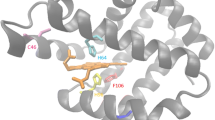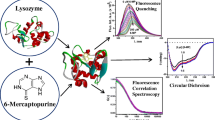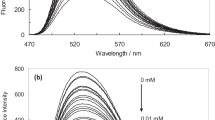Abstract
The influence of new water soluble cationic metalloporphyrin Cu(II)TOEPyP(4) (meso-tetra-(4-N-oxyethylpyridyl)), analogue of Cu(II)TMPyP(4), on thermodynamic stability of DNA at various molar ratios of r = porphyrin/DNA b.p. (0 < r < 0.12) has been studied. It has been shown that Cu(II)TOEPyP(4) is a strong stabilizing agent for calf thymus DNA increasing its melting temperature from 75.5 to 99.5 °C, in the range 0 < r < 0.06. The melting enthalpy (∆H m) does not change in the range 0.002 < r < 0.06 and it equals to 11.6 ± 0.8 cal/g. At r > 0.07, ∆H m and T m decrease, and at r = 0.12 they equal to 6.4 ± 0.6 cal/g and 92.5 °C, accordingly. We suggest that such centers of binding are the well documented 5′CG3′ sites and G-quadruplex at r < 0.01, and negatively charged phosphate groups at r > 0.01. On the basis of ∆H m invariability with simultaneous increase of T m in the range 0.002 < r < 0.06, it is shown that the DNA-Cu(II)TOEPyP(4) complex melting is not of an enthalpic nature but of an entropic one. The two-phase helix–coil transition of DNA at r < 0.01 is considered as a result of porphyrin redistribution in the melting process.





Similar content being viewed by others
References
Gokakakar SD, Salker AV. Thermal studies of cobalt, iron and tin metalloporphyrins. J Therm Anal Calorim. 2010;101(3):809–13.
Grand CL, Han H, Munoz RM, Weitman S, Von Hoff DD, Hurley LH, Bearss DJ. The cationic porphyrin TMPyP4 down-regulates c-MYC and human telomerase reverse transcriptase expression and inhibits tumor growth in vivo. Mol Cancer Ther. 2002;1:565–73.
Shammas MA, Shmookler RJ, Akiyama M, Koley H, Chauhan D, Hideshima T, Goyal RK, Hurley LH, Anderson KC, Munshi NC. Telomerase inhibition and cell growth arrest following porphyrin treatment of multiple myeloma cells. Mol Cancer Ther. 2003;2(9):825–33.
Balaz M, Bitsch-Jensen K, Mammana A, Ellested GA, Nakanishi K, Berova A. Porphyrins as spectroscopic sensors for conformational studies of DNA. Pure Appl Chem. 2007;79(4):801–9.
Latt KK, Takahashi Y. Fabrication and characterization of a α,β,γ,δ-tetrakis(1-methylpyridinium-4-yl)porphine/silica nanocomposite thin-layer membrane for detection of ppb-level heavy metal ions. Anal Chim Acta. 2011;689(1):103–9.
Waller ZA, Sewitz SA, Hsu SD, Balasubramanian S. A small molecule that disrupts G-quadruplex DNA structure and enhances gene expression. J Am Chem Soc. 2009;131:12628–33.
Gaynutdinov TI, Neumann RD, Panyutin IG. Structural polymorphism of intramolecular quadruplex of human telomeric DNA: effect of cations, quadruplex-binding drugs and flanking sequences. Nucl Acids Res. 2008;36:4079–87.
Ghazaryan AA, Dalyan YB, Haroutiunian SG, Vardanyan VI, Ghazaryan RK, Chalikian TV. Thermodynamics of interactions of TAlPyP4 and AgTAlPyP4 porphyrins with poly(rA)poly(rU) and poly(rI)poly(rC) duplexes. J Biomol Struct Dyn. 2006;24:67–74.
Fiel RJ. Porphyrin-nucleic acid interactions: a review. J Biomol Struct Dyn. 1989;6:1259–74.
Bennett M, Krah A, Wien F, Garman E, Mckenna R, Sanderson M, Neidle S. A DNA-porphyrin minor-groove complex at atomic resolution: the structural consequences of porphyrin ruffling. Proc Natl Acad Sci USA. 2000;97:9476–81.
Lee S, Lee Y-Ae, Lee HM, Lee JY, Kim DH, Kim SK. Rotation of periphery methylpyridine of meso-tetrakis(n-N-methylpyridiniumyl)porphyrin (n = 2, 3, 4) and its selective binding to native and synthetic DNAs. Biophys J. 2002;83:371–81.
Marzilli LG, Banville LD, Zon G, Wilson WD. Pronounced H-1 and P-31 NMR spectral changes on meso-tetrakis(N-methylpyridinium-4-yl)porphyrin binding to poly[d(G-C)]·poly[d(GC)] and to 3 tetradecaoligodeoxyribonucleotides: evidence for symmetric, selective binding to 5′CG3′ sequences. J Am Chem Soc. 1986;108:4188–92.
Mojzes P, Kruglik SG, Baumruk V, Turpin P-Y. Interactions of electronically excited copper(II)–porphyrin with DNA: resonance raman evidence for the exciplex formation with adenine and cytosine residues. J Phys Chem. 2003;107:7532–5.
Pasternack RF, Ewen S, Rao A, Meyer AS, Freedman MA, Collings PJ, Frey SL, Ranen MC, Paula JC. Interaction of copper(II) porphyrins with DNA. Inorg Chem Acta. 2001;317:59–71.
Monaselidze J, Kiladze M, Tananashvili D, Barbakadze Sh, Naskidashvili A, Khizanishvili A, Kvavadze R, Majagaladze G. Free and bound water influence on Spirulina platensis survival. J Therm Anal Calorim. 2006;84(3):613–8.
Monaselidze J, Majagaladze G, barbakadze Sh, Khachidze D, gorgoshidze M, Kalandaze Y, Haroutiunian S, Dalian Y, Vardanian V. Microcalorimetric investigation of DNA, poly(Da)poly(Dt) and poly[D(A-C)]Poly[D(G-T)] melting in the presence of water soluble (meso tetra (4N oxyethylpyridyl) porphyrin) and its Zn complex. J Biomol Struct Dyn. 2008;25:419–24.
McGhee JD. Theoretical calculations of the helix coil transition of DNA in the presence of large, cooperatively binding ligands. Biopolymers. 1976;15(7):1345–75.
Sari MA, Battioni JR, Dupre D, Mansuy D, Le Pecq JB. Interaction of cationic porphyrins with DNA: importance of the number and position of the charges and minimum structural requirements for intercalation. Biochemistry. 1990;29:4205–15.
Ohyama T, Mita H, Yamamoto Y. Study on the complexation between DNA and cationic porphyrin derivatives. Nucl Acids Symp Ser. 2004;48:137–8.
Kubat P, Lang K, Anzenbacher P, Jursikova K, Kral V, Ehrenberg B. Interaction of novel cationic meso-tetraphenylporphyrins in the ground and excited states with DNA and nucleotides. J Chem Soc Perkin Trans. 2000;1:933–41.
Dickerson RE, Drew HR, Conner BN, Wing RM, Fratini AV, Kopka ML. The anatomy of A-, B-, and Z-DNA. Science. 1982;216:475–85.
Author information
Authors and Affiliations
Corresponding author
Rights and permissions
About this article
Cite this article
Monaselidze, J.R., Kiladze, M.T., Gorgoshidze, M.Z. et al. Microcalorimetric study of DNA–Cu(II)TOEPyP(4) porphyrin complex. J Therm Anal Calorim 108, 127–131 (2012). https://doi.org/10.1007/s10973-011-1669-4
Received:
Accepted:
Published:
Issue Date:
DOI: https://doi.org/10.1007/s10973-011-1669-4




